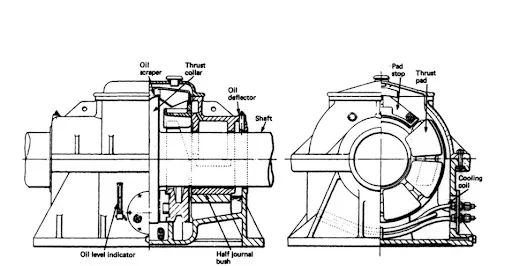The transmission system on a ship transmits power from the engine to the propeller. It is made up of shafts, bearings, and Finally the propeller itself. The thrust from the propeller is transferred to the ship through the transmission system.
The different items in the system include the thrust shaft, one or more intermediate shafts and the tailshaft. These shafts are supported by the thrust block, intermediate bearings and the sterntube bearing. A sealing arrangement is provided at either end of the tailshaft with the propeller and cone completing the arrangement.
Thrust block
The thrust block transfers the thrust from the propeller to the hull of the ship. It must therefore be solidly constructed and mounted onto a rigid seating or framework to perform its task. It may be an independent unit or an integral part of the main propulsion engine.
Both ahead and astern thrusts must be catered for and the construction must be strong enough to withstand normal and shock loads. The casing of the independent thrust block is in two halves which are joined by fitted bolts. The thrust loading is carried by bearing pads which are arranged to pivot or tilt. The pads are mounted in holders or carriers and faced with white metal.
In the arrangement shown the thrust pads extend threequarters of the distance around the collar and transmit all thrust to the lower half of the casing. Other designs employ a complete ring of pads. An oil scraper deflects the oil lifted by the thrust collar and directs it onto the pad stops.
From here it cascades over the thrust pads and bearings. The thrust shaft is manufactured with integral flanges for bolting to the engine or gearbox shaft and the intermediate shafting, and a thrust collar for absorbing the thrust.
Where the thrust shaft is an integral part of the engine, the casing is usually
fabricated in a similar manner to the engine bedplate to which it is bolted. Pressurised lubrication from the engine lubricating oil system is provided and most other details of construction are similar to the independent type of thrust block.
Shaft bearings
Shaft bearings are of two types, the aftermost tunnel bearing and all others. The aftermost tunnel bearing has a top and bottom bearing shell because it must counteract the propeller mass and take a vertical upward thrust at the forward end of the tailshaft. The other shaft bearings only support the shaft weight and thus have only lower half bearing shells.
The usual journal bush is here replaced by pivoting pads. The tilting pad is better able to carry high overloads and retain a thick oil lubrication film. Lubrication is from a bath in the lower half of the casing, and an oil thrower ring dips into the oil and carries it round the shaft as it rotates. Cooling of the bearing is by water circulating through a tube cooler in the bottom of the casing.
Sterntube bearing
The sterntube bearing serves two important purposes. It supports the tailshaft and a considerable proportion of the propeller weight. It also acts as a gland to prevent the entry of sea water to the machinery space. Early arrangements used bearing materials such as lignum vitae (a very dense form of timber) which were lubricated by sea water.
Most modern designs use an oil lubrication arrangement for a white metal lined sterntube bearing. Oil is pumped to the bush through external axial grooves and passes through holes on each side into internal axial passages. The oil leaves from the ends of the bush and circulates back to the pump and the cooler.
One of two header tanks will provide a back pressure in the system and a period of oil supply in the event of pump failure. A low-level alarm will be fitted to each header tank. Oil pressure in the lubrication system is higher than the static sea water head to ensure that sea water cannot enter the sterntube in the event of seal failure.
Sterntube seals
Special seals are fitted at the outboard and inboard ends of the tailshaft. They are arranged to prevent the entry of sea water and also the loss of lubricating oil from the stern bearing.
Older designs, usually associated with sea water lubricated stern bearings, made use of a conventional stuffing box and gland at the after bulkhead. Oil-lubricated stern bearings use either lip or radial face seals or a combination of the two. Lip seals are shaped rings of material with a projecting lip or edge which is held in contact with a shaft to prevent oil leakage or water entry.
A number of lip seals are usually fitted depending upon the particular application. Face seals use a pair of mating radial faces to seal against leakage. One face is stationary and the other rotates. The rotating face of the after seal is usually secured to the propeller boss. The stationary face of the forward or inboard seal is the after bulkhead. A spring arrangement forces the stationary and rotating faces together.
More Details About This Topic Click Here :




Post a Comment